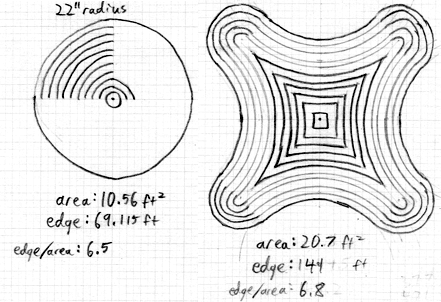When I teach intro classes on permaculture design, when we're talking about boundary optimization -- that is, when to maximize the edge and when to minimize it -- one of the questions I like to ask students is along the lines of, "How many strawberry plants, spaced 6" apart, can you fit in 16 square feet and still reach them all easily for harvest?" The exact numbers are not important; what I'm looking for is the ideal design of a strawberry planter to maximize production in a minimum of space.
Why strawberries, specifically? Because strawberries present some challenges compared to, say, lettuce:
- the berries grow underneath the leaves, so they're hard to see from above
- although strawberries are perennial and spread by runners, they produce most in their first year, so it's desirable to get rid of last year's plants, which means you need to be able to tell one year's plants from the next
 I like to give the students a hint by showing them an example of a strawberry pyramid, like the one at right. By raising the plants up on tiers, the berries can be easily seen from the side, and the runners will always go down to the level below, so a parent plant can be distinguished from a child. Simple and elegant. But is this the optimal shape?
I like to give the students a hint by showing them an example of a strawberry pyramid, like the one at right. By raising the plants up on tiers, the berries can be easily seen from the side, and the runners will always go down to the level below, so a parent plant can be distinguished from a child. Simple and elegant. But is this the optimal shape?
A circle minimizes edge for a given area, which is great when edge is a liability, but in this case you're only planting the edge, so what you really want to do is maximize the edge. What shape would maximize the edge while keeping every plant within reach?
 Well, that raises the question, how far can you reach at various heights? One way to find out... I put a measuring tape up against the wall and a yardstick at my feet and created the chart at left. (The funny shape at lower left represents my shoe.) What I found is that at 5 feet -- with my arms straight out from the shoulders -- I can reach 26", but from 3' down to 1' above the ground I can only reach out 20" (with my arms at a diagonal and my knees or back progressively bent), and on ground level I can only reach 15" -- if I keep my feet flat on the ground. If I rock forward onto my toes, I can reach 24" on the ground, but that's not sustainable; generally when I'm tending a 4' wide bed and reaching 2' in, I'm on my hands and knees rather than my toes.
Well, that raises the question, how far can you reach at various heights? One way to find out... I put a measuring tape up against the wall and a yardstick at my feet and created the chart at left. (The funny shape at lower left represents my shoe.) What I found is that at 5 feet -- with my arms straight out from the shoulders -- I can reach 26", but from 3' down to 1' above the ground I can only reach out 20" (with my arms at a diagonal and my knees or back progressively bent), and on ground level I can only reach 15" -- if I keep my feet flat on the ground. If I rock forward onto my toes, I can reach 24" on the ground, but that's not sustainable; generally when I'm tending a 4' wide bed and reaching 2' in, I'm on my hands and knees rather than my toes.
So from this information, the most space-saving way to grow strawberries would be vertically, up against a wall, for example a retaining wall or a series of old rain gutters filled with soil. In this way the 16 square feet of the original question could hold hundreds upon hundreds of plants. But suppose we don't have a wall and have to build a planter; how steep and how tall can the planter be? I estimate a plant needs about 2" of soil around it to anchor it and absorb water, so I sketched on the chart a series of tiers 4" tall and 2" deep. I can then have 11 tiers totaling 44" high before exceeding my reach of 22" at that height.
 Maximizing the edge of the planter is important because the upper tiers are necessarily smaller than the lower ones, so if you can stretch the planter lengthwise into a two-sided wall, that's going to be your best bet. But suppose you can't stretch it lengthwise? How can we maximize edge without increasing length? The easiest way is to stretch it out into an amoeba shape (shown at left).
Maximizing the edge of the planter is important because the upper tiers are necessarily smaller than the lower ones, so if you can stretch the planter lengthwise into a two-sided wall, that's going to be your best bet. But suppose you can't stretch it lengthwise? How can we maximize edge without increasing length? The easiest way is to stretch it out into an amoeba shape (shown at left).
The trouble with the amoeba shape is that, at 44" high, parts of it are going to be in shade almost all the time. Strawberries need sunlight to produce fruit. So we not only need to maximize edge, we need to maximize edge exposed to the sun and minimize the edge that's in shade.
 When I started sketching shapes with more edge on one side than the other, I was frustrated that most of them were really ugly. Jessie asked me what I was doing and casually suggested, "How about a heart?" Hm... well, how about it? I'm now building a 44" high heart-shaped strawberry pyramid (right)! The top is reachable from three directions, there's more edge in sun than in shade (the point goes north), and it's aesthetically pleasing! Is it optimal? No, up against a wall would be optimal. I'm happy with this compromise!
When I started sketching shapes with more edge on one side than the other, I was frustrated that most of them were really ugly. Jessie asked me what I was doing and casually suggested, "How about a heart?" Hm... well, how about it? I'm now building a 44" high heart-shaped strawberry pyramid (right)! The top is reachable from three directions, there's more edge in sun than in shade (the point goes north), and it's aesthetically pleasing! Is it optimal? No, up against a wall would be optimal. I'm happy with this compromise!
[update: I did not complete this project, because the plastic edging I was using to reinforce the tiers was not strong enough to resist the expansion of freezing soil in the winter! So the moral of the story is, a design must be appropriate to the materials. For anyone with heavy clay soil, I cannot recommend any shape other than linear, since if you try to contain the soil on all sides, it will bust free when it freezes.]
What do you think? Comment below!
- Log in to post comments





Comments